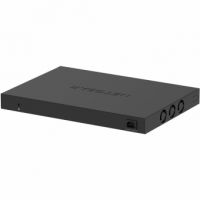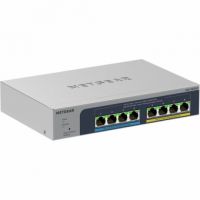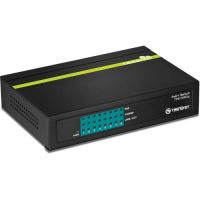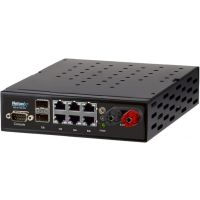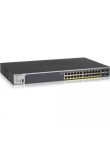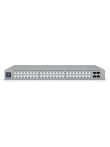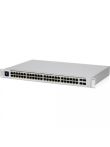PoE Switches
- Netgear 24-Port Multi-Gigabit Ethernet Ultra60 PoE++ Smart S...
 In Stock
In StockBrand: Netgear SKU: MS324TXUP-100NAS Condition: New USD 1654.51 - Netgear 8-port Ultra60 PoE++ Multi-Gigabit (2.5G) Ethernet S...
 Out of Stock
Out of StockBrand: Netgear SKU: MS108TUP-100NAS Condition: New Call us for price(669) 244-0333
- TRENDnet TPE-TG80G 8-Port Gigabit GREENnet PoE+ Switch
 In Stock
In StockBrand: TRENDnet SKU: TPE-TG80G Condition: New USD 108.95 - USD 0.00Netonix WS-8-150-DC 8-Port Managed POE Switch DC 150 Watt
 Out of Stock
Out of StockBrand: Netonix SKU: WS-8-150-DC Condition: New Call us for price(669) 244-0333
PoE Network Switch Buying Guide in 2025
Today, we are living in a hyper-connected world thanks to the ever-increasing and deepening penetration of networks in our daily and professional lives. In order to enjoy the dividends of this network-centric world, you need to have a reliable network infrastructure comprising routers, access points, switches, VoIP phones, and the like. Needlessly to say, this infrastructure needs both power supply and data, which requires installing separate cables. However, the introduction of Power Over Ethernet or PoE technology has made the deployment and operationalization of network devices quite easy and simple.
PoE technology helps you provide both power and data through a single Cat5e or Cat6 cable, eliminating the requirements of separate cables. You can thus cut both cable clutter as well as price, making it convenient for network administrators to keep running the network infrastructure, whether wired or WiFi. Having said that, PoE switches come in various specifications that can make it harder for users to choose the best PoE network switch that can meet their networking needs in the USA.
In this write-up, we will help you understand the ins and outs of these Power Over Ethernet switches, including key specifications you need to know, allowing you to make a well-informed decision.
What is a PoE Switch:
Simply speaking, Power Over Ethernet switches are network switches that can transfer both power and data through one Cat cable, normally Cat5 or Cat6 cables. You don’t need to install separate cables. Ethernet switches are used in wide-ranging applications in the USA. For instance:
-
Voice Over Internet Protocol
-
Wireless Access Points
-
Building automation
-
Factory automation
-
Intelligent transportation system
-
Retail displays
-
Manufacturing execution system
-
Security system
How Does a POE Switch Work?
Here are some steps involved in the working of PoE switches.
-
The Power Injection Process:
The operation of PoE Ethernet switches starts with the process that is dubbed as power injection. There is a power supply inside the switch that is connected to the power injector circuit. When users add an Ethernet cable to a PoE-enabled port on the switch, the power injector circuit starts supplying electrical power to the cable.
-
Power and Data Transmission:
The same Ethernet cable carries both data and power, which is connected to PoE-enabled devices that can be an IP camera, a wireless access point, VOIP phone, router, or another switch.
-
Power Extraction at the Device:
Finally, in PoE-enabled devices, power and data are separated with the help of a component known as a PD (Powered Device) splitter. Power is used to run the device, and data is forwarded to the device’s network interface.
Types of PoE Switches:
The IEEE (Institute of Electrical and Electronics Engineers) defines types of PoE switches on the basis of output level. The IEEE divides PoE switches into 4 broad categories:
-
Type 1 (802.3af Standard) PoE Switches
-
Type 2 (IEEE 802.3at Standard) PoE switches
-
Type 3 (IEEE 802.3bt Standard) PoE switches
-
Type 4 (IEEE 802.3bt Standard) PoE switches
-
802.3af Standard PoE Ethernet Switches:
It is also known as a PoE switch, which was introduced back in 2003. They come with two wire pairs, one for data transmission and another for power supply. They can provide up to 15.4W (watts) of power; however, due to power dissipation in the cable, the actual output available for connected devices is around 12.95W.
-
IEEE 802.3at Standard) PoE+ switche:
They were introduced in 2009, and PoE+ switches represent the boosted version of PoE switches. They can provide theoretically 30W of power output, which, after power dissipation is accounted for, remains 25.5W for connected devices.
Similar to PoE Ethernet switches, they also come with two wire pairs, one for power and another for data transmission.
-
IEEE 802.3bt Standard) PoE++ switches:
They are called 4PPoE (Four-Pair Power over Ethernet) or Ultra PoE. They were introduced in 2018, and they are designed to utilize all four pairs of wires in Ethernet cables. Therefore, they can support 60W of power output. However, devices receive 51W of power due to power dissipation.
-
Type 4 (IEEE 802.3bt Standard) PoE switches:
Type 4 PoE++ was also introduced along with the Type 3 PoE switch in 2018. Like type 3, it is also dubbed as 4PPoE, and it can use all four pairs of wires in Ethernet cables. However, it comes with a higher PoE budget that can be as high as 100W. However, connected devices receive 71.3W after cable dissipation.
PoE vs PoE+ vs PoE++: Which PoE Standard Best Meets Your Needs in the USA
Here is a table providing a comparative analysis of these IEEE standards.
|
Features |
Type 1 |
Type 2 |
Type 3 |
Type 4 |
|
Common name |
PoE |
PoE+ |
PoE++ |
PoE++ |
|
PoE Standard |
IEEE 802.3af |
IEEE 802.3at |
IEEE 802.3bt |
IEEE 802.3bt |
|
PSE Min. Output |
15.40 W |
30 W |
60 W |
90 W |
|
Voltage Range |
44V-57V |
50V-57V |
50V-57V |
52V-57V |
|
Application Examples |
|
|
|
|
Types of PoE Switches based on Management Capabilities:
PoE switches can also differ in terms of customization and management capabilities. Here are some categories in this regard.
-
Managed PoE Switches
-
Unmanaged PoE Switches
-
Smart PoE Switches
Managed PoE Switches in the USA:
Managed PoE switches are the most advanced network switches, offering advanced capabilities. For instance, they support remote management via configuration of VLANs, monitoring traffic, and setting QoS rules via web, SNMP, or CLI.
Similarly, they also come with power Control via allocation of PoE budget per port, monitoring power usage, and rebooting devices remotely. These switches feature robust security safeguards such as support for 802.1X authentication, RADIUS, and access control lists.
Top Managed PoE Switches in the USA:
-
8-port POE+: Cisco Meraki MS130-8P
-
24-port POE+: Cisco Meraki MS130-24P
-
48-port POE+: Cisco Meraki MS130-48P
-
UniFi Switch Pro Series (e.g., USW-Pro-48-PoE)
-
NETGEAR Smart Managed Pro Series (GS7xxTP, GS7xxTPP
-
HPE Aruba 2930M JF774A
-
CBS350-48FP-4G
-
UniFi Switch Enterprise 24 PoE (USW-Enterprise-24-PoE)
-
NETGEAR GS728TPPv2
-
NETGEAR GS752TPPv2
Unmanaged PoE Network Switches:
Unmanaged PoE Ethernet switches are the simplest network switches, providing no or little management or configuration capabilities. They are plug-and-play switches, suitable only for connecting multiple Ethernet switches like switches, routers, access points, and the like.
They are recommended for home networks, small offices, IoT deployment, and simple surveillance systems.
Top Unmanaged PoE Ethernet Switches in the USA:
-
8-Port PoE+: Netgear GS308PP
-
16-Port PoE+: Netgear GS516PP
-
24-Port PoE+: Netgear GS324PP
-
TP-Link TL-SG1008P
-
Netgear GS308P
-
D-Link DGS-1100-08P
-
TP-Link TL-SG1024P
-
TP-Link TL-SG1016PE
Smart PoE Switches:
These switches sit between advanced managed switches and simple unmanaged switches, offering some level of configurability through a web interface, but that is not as advanced as what managed switches offer.
Top Smart PoE Switches in the USA:
-
TP-Link TL-SG105E
-
TP-Link TL-SG108E
-
TP-Link TL-SG2008
-
TP-Link TL-SG116E
-
Netgear GS305E
-
Netgear GS308E
-
D-Link DGS-1100-05
-
Zyxel GS1200-8
-
NETGEAR GS108T
Wrapping Up:
The choice of the right PoE switch is very important for home and office networks in the United States. PoE switches offer simplified network installation, cost-effective deployment of network devices, centralized management, and convenient network troubleshooting, configuration, control, and remote monitoring.
However, the USA market is flooded with multiple brands such as TP-Link, Ubiquiti Networks, Axis Communications, HPE, Netgear, among others, that are offering switches of various sizes and configurations. In this blog, we have attempted to help you understand the basics of PoE switches so that you can make the right choice when it comes to the best PoE Ethernet switch in the USA. Thanks for your reading.



